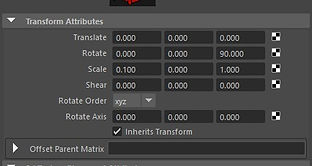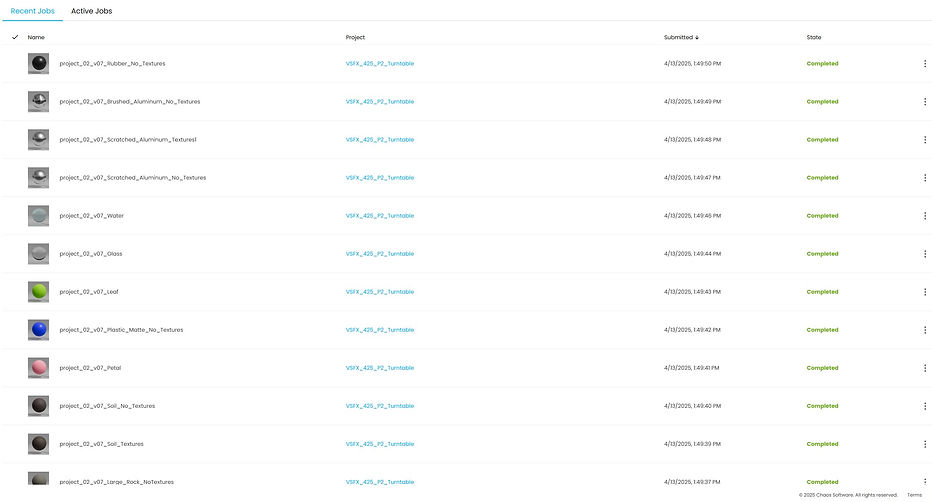
Look Development
Project 2
Final Submission
VFX_425/Class_3
Today was the basic setup for the second project, Look Development. We are using V-Ray to construct a look development "quilt" full of different materials, each with their own properties. I worked on the first two materials for the project during and after class 3.

Matte Plastic
The first material I worked on was a matte plastic material. This was a relatively easy one to work on, but since I was basing it on a real life (a bottle) I had to put in a plastic seam where the two ends had been connected in production.
This was done with a VERY stretched grid node as to create the illusion of a seam. I also added some noise in the bump to break up the highlight on the mesh to make it seem more like a plastic material.

Brushed Aluminum
The second material I worked on was brushed aluminum. This material required a few more specific parameters than the matte plastic, including altering the anisotropy of the reflections.

The node setup for the aluminum only required a single map, that being a procedural noise map. However, the bump doesn't look noisy at all. This is because the scale parameters are set to extremely low values to create the stretched lines. The great thing is that this map is procedural, so it's very flexible!


VFX_425/Class_4
Over the weekend I had the opportunity to work more extensively with V-Ray and its shaders. I produced 4 more materials on top of the plastic and aluminum mats I made last class.
Quilt Layout

The quilt that we have to produce consists of 21 total materials that we have to produce. The quilt has a bit more room for any extras we want to create.
New Materials
V-Ray does materials a bit differently than what I'm used to, especially when it comes to transmission. Instead of using transmission, V-Ray relies on a refraction section to accomplish glass. However, it function in almost exactly the same way. There are just a couple extra options for more control.
On top of the glass I also worked on 3 new metal materials. The most challenging part of metal in general is getting the reflections and color to behave correctly together. It's a lot of editing values until something works.



While copper and gold were relatively straightforward, the scratched aluminum material required a bit extra. I used a custom grunge map from Quixel to create the scratches in the metal below. It was fed into the bump and the roughness. I had to remap the roughness to bring the levels in line with what was needed. Funnily enough, I actually took a lot of the parameters from the brushed aluminum material.


VFX_425/Class_5
I had a little bit of time to work between classes 4 and 5, and that time was spent tweaking and adjusting small things.
Hero Layout


These render layers are relatively easy to set up and they speed up the rendering process exponentially. Each layer can be rendered with material overrides, so it's as simple as copying the layer and changing the material of the hero sphere.
On top the quilt, we are also required to showcase each of our material individually. This means rendering a large scale version of each sphere that takes up ~75% of the available screen space. Rendering each material manually is a lot of work, but that can be fixed with the help of render layers.
Minor Tweaks
I made a few smaller adjustments to the scene and materials as well. I updated the background of the quilt to be a white instead of the checkerboard pattern. I also added a water material (same concept as glass) and worked on a new chrome material but with a TWIST: it's got a painted checkerboard on it.

VFX_425/Class_6
Class 6 gave me the final piece to put together what was the finished project 2! Below is the final steps I took to creating the last few materials and the setup for rendering.
Final Material Layout
The weekend gave me a lot of time to refine and finish creating all the of the materials required to complete the quilt. The image on the right showcases the finished quilt.

SSS in V-Ray

A couple of the materials required subsurface scattering (SSS) and V-Ray handles SSS a little differently than most engine. Rather than having SSS built directly into the standard material, there is a separate material called VrayFastSSS. There is also an AIStandard shader for V-Ray which includes similar options, but I wanted to try out this one. The settings are pretty standard to most other render engines, although there are a few extra controls that make it more flexible.

Rendering with Chaos Cloud
Once a job is submitted it's rendered to a project right on the cloud where it can be immediately downloaded.


V-Ray has a neat built-in feature for cloud-based rendering that runs right out of the box. Using something called Chaos Cloud, I could upload my file seamlessly to my browser from V-Ray with all of the data I need already packed in.


